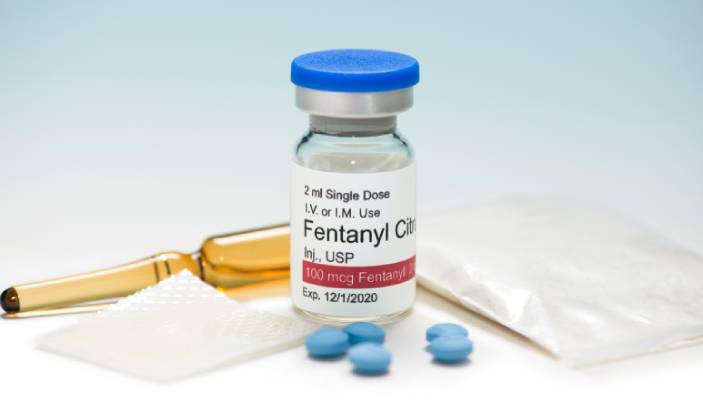Pain relievers, known in the medical world as analgesics, are a significant pillar of modern medicine. These medications range from over-the-counter options like aspirin and ibuprofen to more potent substances like opioids.
They bring relief to individuals suffering from a wide spectrum of pain, from minor aches and headaches to intense discomfort following surgeries or due to chronic conditions. Their role in pain management strategies is crucial, improving the quality of life for countless individuals worldwide.
However, despite the undeniable benefits, pain relievers also have potential downsides. Specifically, the use of powerful opioid pain relievers presents significant challenges due to their highly addictive nature. The capacity of these drugs to induce a feeling of euphoria and relieve pain opens the door to potential misuse and addiction.
One such powerful opioid that perfectly illustrates this dichotomy is Fentanyl, a potent drug originally intended for severe pain management but has, unfortunately, found its way into the dangerous landscape of substance misuse.
Fentanyl: An Overview
Fentanyl falls into the category of opioids, a family of drugs including heroin, morphine, and prescription pain relievers. It’s a synthetic substance manufactured in labs, which gives it a unique character compared to naturally derived opioids such as morphine or codeine.
Since Fentanyl is stronger than heroin or morphine, even a small amount can be highly effective in managing severe, chronic pain, especially pain that doesn’t respond to other opioids.
Opioid receptors are found in areas of the brain that control pain and emotions. When Fentanyl is attached to these receptors, it drives up the level of dopamine in the brain’s reward areas, resulting in a state of relaxation and euphoria, along with pain relief.
This mechanism makes Fentanyl effective in treating severe pain. For patients suffering from chronic pain conditions or recovering from significant surgeries, Fentanyl can provide necessary respite when other treatments are inadequate.
Doctors prescribe Fentanyl for severe pain management, and it’s available in various forms, such as patches, injections, and lozenges. In a controlled medical setting, professionals monitor its usage closely due to its high potency, ensuring that patients receive pain relief benefits without the risk of significant side effects or dependency.
Fentanyl, therefore, represents a crucial tool in a physician’s arsenal for managing severe and unresponsive pain, offering patients a chance at a more comfortable and manageable life. However, the benefits of using Fentanyl for pain relief can easily turn risky.
From Euphoria To Peril: Unmasking The Risks Of Fentanyl
When someone uses Fentanyl without a prescription or in a way not prescribed by a doctor, the results can be lethal. This powerful opioid affects the brain’s areas that control pain and emotions, intensifying feelings of happiness and relaxation. The strength and speed at which Fentanyl acts can rapidly lead to dependence, addiction, and worse, death.
On The Edge Of A Razor: Overdose And Death From Fentanyl Misuse
The same characteristic that makes Fentanyl a powerful tool for pain management—its extraordinary potency—also gives rise to one of its most significant risks: overdose. Misuse of Fentanyl, such as taking it without a prescription or in larger doses than prescribed, can easily tip the scale towards an overdose due to its strength. An amount equivalent to a few grains of salt could be enough to lead to an overdose, underscoring the razor-thin margin between a therapeutic dose and a fatal one.
An overdose of Fentanyl manifests through a series of dire symptoms. The drug depresses the central nervous system, slowing breathing or, in severe cases, causing it to stop entirely. The lack of oxygen reaching the brain can cause hypoxia, which can lead to coma, permanent brain damage, or death. Additionally, Fentanyl overdose can cause a drop in heart rate, severe drowsiness, and loss of consciousness.
The risk of Fentanyl overdose becomes even more pronounced in the context of its illicit use. Often, illegal manufacturers mix Fentanyl with other drugs such as heroin, cocaine, or methamphetamine to amplify their effects. These combinations are particularly dangerous as users may be unaware of the presence of Fentanyl, leading them to unwittingly consume a lethal dose.
This trend has contributed significantly to the current opioid crisis, with Fentanyl-related overdoses seeing a drastic surge. Thus, while it serves as a beacon of relief for those struggling with severe pain, its misuse can quickly descend into a perilous journey, underscoring the importance of controlled, professional supervision in its use.
Walking The Tightrope: Fentanyl Addiction, Dependence, And The Path To Recovery
Fentanyl’s potency not only puts users at risk of overdose but also opens the door to addiction and dependence. The drug’s effect on the brain’s reward center, which drives up dopamine levels, leads to intense but short-lived euphoria. This brief but powerful sensation often leads users to take more of the drug to replicate or maintain the feeling, creating a cycle of misuse.
Frequent use of Fentanyl changes the brain’s structure and function over time, making the desire for the drug an irresistible compulsion. This marks the transition from misuse to addiction. Addiction is a chronic, relapsing disease characterized by the compulsive seeking and use of a drug, despite harmful consequences.
Physical dependence on Fentanyl, characterized by withdrawal symptoms upon stopping the drug, can also occur with regular use. Withdrawal symptoms can include cold flashes with goosebumps, diarrhea, insomnia, goosebumps, muscle and bone pain, restlessness, vomiting, and involuntary leg movements.
Despite the daunting challenges addiction and dependence present, recovery is possible with the right treatment. Fentanyl addiction treatment often includes medications and behavioral therapies. Medications like methadone, buprenorphine, and naltrexone can effectively manage withdrawal symptoms and cravings, while behavioral therapies help patients change their attitudes and behaviors related to drug use. Treatment is often tailored to each individual’s specific needs, considering their medical history, the severity of their addiction, and their personal circumstances.
Fentanyl addiction treatment seeks to help individuals regain control of their lives and move towards a healthier, drug-free future. Recovery can be a long process, but with the right support and treatment, individuals struggling with Fentanyl addiction can find their way back to health and well-being. The challenge of Fentanyl addiction underscores the need for careful use of this potent pain reliever and highlights the importance of comprehensive addiction treatment services.
The Echoes Of Misuse: Health Effects Of Fentanyl
Fentanyl misuse has a profound impact on the physical and mental health of individuals. Beyond the immediate risks of overdose and the development of addiction and dependence, chronic Fentanyl misuse can lead to a myriad of long-term health effects.
- Physical Health Effects
Misuse of Fentanyl can have long-lasting effects on the body. Chronic users may experience severe gastrointestinal problems, including constipation, bloating, and nausea. This opioid can also cause respiratory issues, which can range from slowed breathing to acute respiratory distress or failure, especially in the event of an overdose.
Prolonged Fentanyl misuse can also lead to a weakened immune system, making individuals more susceptible to infections. In some cases, it can also result in hormonal imbalances, leading to a decreased sex drive, irregular menstrual cycles, infertility, and an overall decrease in body energy.
Long-term misuse of Fentanyl also affects the cardiovascular system. Chronic use can lead to an irregular heart rate, increased heart rate, or more serious conditions like heart failure. The risk increases if Fentanyl is combined with other substances, such as alcohol or stimulants, which further strain the heart.
Another critical concern is the potential for damage to the liver and kidneys. These organs play a crucial role in filtering toxins, including drugs, from the body. The overwhelming presence of Fentanyl and other toxins can lead to organ damage over time, potentially resulting in liver or kidney disease.
Furthermore, the risk of contracting blood-borne diseases increases with the intravenous use of Fentanyl, especially when sharing needles. Diseases such as HIV and Hepatitis C can spread through this form of misuse, leading to additional health complications.
The physical toll of chronic Fentanyl misuse is comprehensive, affecting nearly every system within the body. It underlines the importance of addressing Fentanyl misuse promptly and effectively to prevent these severe health complications. - Mental Health Effects
The cycle of euphoria and withdrawal associated with Fentanyl misuse can significantly impact an individual’s emotional well-being. When Fentanyl enters the body, it triggers a surge of dopamine, creating a feeling of intense happiness or euphoria. However, this heightened state is short-lived, and when the drug wears off, the individual may experience a dramatic mood dip. This constant up and down can result in mood swings, where individuals oscillate between periods of ecstasy and periods of depression or anxiety.
In addition to mood swings, the cycle of drug use and withdrawal can also lead to emotional instability. Individuals may become more prone to emotional reactions and may struggle to control their emotions effectively. This emotional turbulence can affect relationships, job performance, and overall quality of life.
Prolonged misuse of Fentanyl can also lead to paranoia, a mental condition characterized by irrational suspicion and mistrust of others. Paranoia can manifest as unjustified fears that others are ‘out to get them’, or that they’re being constantly watched or followed. This constant state of fear and suspicion can be isolating and distressing and can significantly impair an individual’s ability to function socially and professionally.
In some cases, Fentanyl misuse can result in hallucinations. Hallucinations involve sensing things that aren’t actually there, such as hearing voices, seeing things, or feeling sensations on the skin. These can be extremely disturbing and can further contribute to paranoia and emotional instability.
Long-term Fentanyl misuse can also lead to cognitive impairment, affecting an individual’s ability to think, learn, and remember. Misuse can alter brain structures and functions, leading to difficulties in making decisions, solving problems, and controlling behavior. This cognitive impairment can impact every aspect of an individual’s life, from their job performance to their relationships and personal life.
It’s crucial to note that these mental health disorders can coexist, leading to a complex mental health picture that can be challenging to address. However, with the right mental health support and addiction treatment, these conditions can be effectively managed, and individuals can reclaim their lives from the grip of Fentanyl misuse. - Social and Economic Consequences
In addition to physical and mental health effects, Fentanyl misuse often has significant social and economic consequences. It can lead to broken relationships, job loss, financial hardship, and social isolation. Individuals struggling with addiction may also face legal problems due to drug-related offenses.
In sum, the misuse of Fentanyl can have a far-reaching impact on an individual’s life, affecting their physical health, mental well-being, and socio-economic status. Therefore, it’s critical to raise awareness about the potential dangers of Fentanyl misuse and provide resources for prevention, treatment, and recovery. - Crisis At Our Doorstep: The Fentanyl Epidemic And The Public Health Counterstrike
The proliferation of Fentanyl misuse has resulted in a public health crisis that has swept across nations, cutting across social, economic, and demographic boundaries. This crisis manifests not only in the alarming surge of overdose deaths but also in the escalating number of individuals wrestling with Fentanyl addiction and the ripple effects this has on communities and healthcare systems.
Emergency departments and hospitals are at the frontline of this crisis. They face the daunting task of managing a surge in overdose cases, which strains resources and threatens the overall quality of care. The cost isn’t only financial but also human, as healthcare professionals grapple with the emotional toll of witnessing the tragic impact of the epidemic.
At the same time, communities reel under the impact of the crisis. Families lose loved ones to overdoses, while those who battle addiction face stigma, isolation, and a range of health and social issues. This epidemic, therefore, doesn’t only affect individual users but also impacts the lives of many others.
In response to this crisis, public health entities at all levels, from local to international, have taken up arms against the epidemic. They are employing a multi-pronged approach that includes prevention, treatment, harm reduction, and policy initiatives.
Prevention strategies focus on educating the public about the risks of Fentanyl misuse and promoting responsible prescribing among healthcare providers. Simultaneously, increased investment is being funneled into expanding access to treatment and recovery services for those struggling with addiction.
Harm reduction approaches aim to reduce the immediate risks associated with Fentanyl misuse. This includes promoting the use of naloxone, an overdose-reversing drug, and implementing programs like supervised consumption sites where users can take drugs under medical supervision.
Policy initiatives, on the other hand, target the root of the problem, addressing issues such as illicit drug supply, healthcare access, and social determinants of drug use.
The Fentanyl crisis demands a robust and multifaceted response from public health entities. Through concerted efforts in prevention, treatment, harm reduction, and policy changes, it’s possible to turn the tide against this devastating epidemic.
Final Thoughts
Indeed, the potency of Fentanyl that makes it an effective pain reliever can quickly become a double-edged sword when misused. From the perilous risk of overdose to the insidious development of addiction and dependence, misuse takes a significant toll on the health and well-being of individuals.
The physical health effects are wide-ranging, and the mental health consequences are equally concerning. They drastically affect an individual’s quality of life and ability to function in society. Additionally, the socio-economic impact of misuse extends beyond the individual, affecting families, communities, and nations.
In the face of the escalating Fentanyl crisis, public health entities at all levels are stepping up to counteract the epidemic. The focus is on multifaceted strategies involving prevention, treatment, harm reduction, and policy changes. With increased awareness, targeted interventions, and robust support systems, it’s possible to overcome the peril of Fentanyl misuse and move towards healthier, safer communities.









